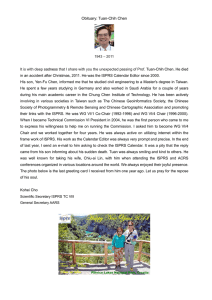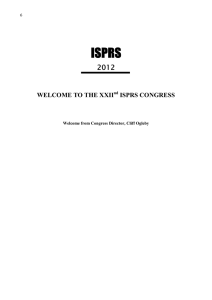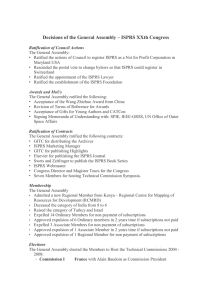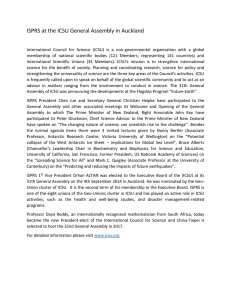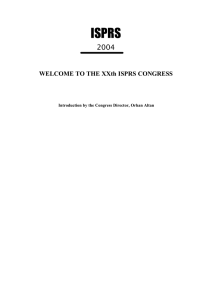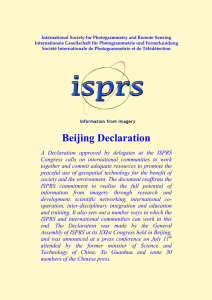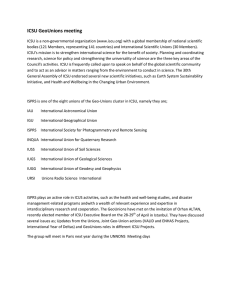ISPRS 2012 OPENING CEREMONY AND FIRST PLENARY SESSION
advertisement
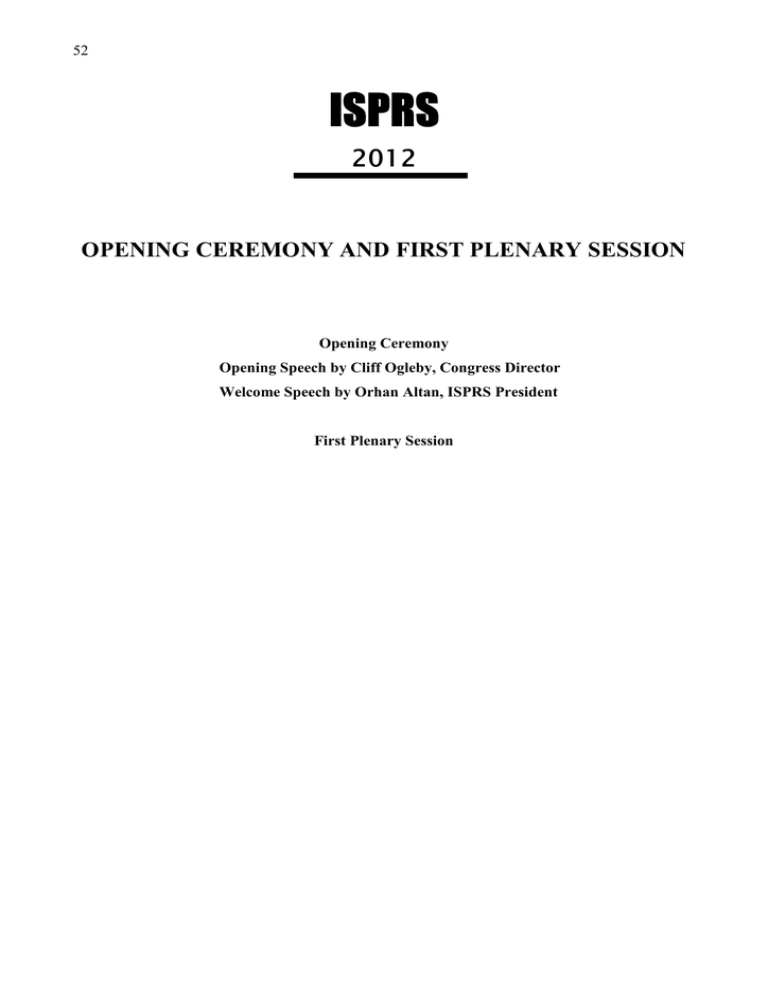
52 ISPRS 2012 OPENING CEREMONY AND FIRST PLENARY SESSION Opening Ceremony Opening Speech by Cliff Ogleby, Congress Director Welcome Speech by Orhan Altan, ISPRS President First Plenary Session 53 OPENING CEREMONY Program of the Opening Ceremony Introductory Remarks and Welcome to Country • Presentation of U.V. Heleva Award • Presentation of Wang Zhizhuo Award Opening Address by Congress Director, Cliff Ogleby Proposal of the Fellows Address by ICSU Secretary General, David Black Proposal for ISPRS Honorary Membership Welcome Address by ISPRS President, Orhan Altan Cultural Show Presentation of Awards Opening of the XXII Congress • Presentation of Brock Gold Medal Award Musical Interlude • Presentation of Otto von Gruber Award Welcome Reception OPENING SPEECH BY CLIFF OGLEBY, CONGRESS DIRECTOR The Welcome Address was given by The Congress Director, Mr. Cliff Ogleby. WELCOME SPEECH BY ORHAN ALTAN, ISPRS PRESIDENT Distinguished Guests, Ladies and Gentlemen, It is my great pleasure to welcome you all to the twenty second ISPRS Congress. I would immediately like to thank our Australian hosts for the immense effort which they have put into organizing this Congress. Professor Cliff Ogleby and his team are responsible for the organization of the congress and they should take the credit for what I am sure will be a highly successful event. I would also like to thank my colleagues on Council and the Technical Commission Presidents who have also worked hard to produce an excellent program. David Tait, Hans-Karsten Meier, Vladislav K. Lvov, Tuan-Chih Chen, Myriam Ardilla–Torres, George Zarzycki, Hans Georg Jerie and Ian Harley. A Congress such as this is more than a meeting of ISPRS members. It is also an opportunity to show our work to others and to look for opportunities to collaborate and I am delighted that we have with us many distinguished guests from other societies. I would also particularly like to welcome those young people amongst us, who have been funded by the ISPRS Foundation, Congress travel grants, and Young Authors Awards. The ISPRS Foundation makes it possible for many people to attend the Congress, who would not otherwise be able to, and I hope that everyone will support the fundraising activities of the Foundation here in Melbourne. Australia is a very appropriate venue for the Congress. Here in this venue last year our colleagues from IUGG had a very successful congress and the year before we have had the FIG Congress in Sydney. Australia is a very interesting and diverse continent and we look forward to learning more about this country and to experience the mixture of ancient and modern cultures. I would like to pause here for a moment to remember those of our number who have passed away during the past four years: Jörg Albertz, Robert “Bob” Moses, This is an occasion to which we have looked forward since the end of the previous Congress. We left Beijing with enthusiasm for our society, with many ideas for new research, new activities and making new contacts and forming new collaborations. Now we meet again to see whether these ambitions have been met. I promised in Beijing to develop our science and to promote the Society globally, to take care of the Societal Benefits of our sciences involved and to work especially in Disaster Management. Many of you have come here to find out about new developments and to recharge your batteries with new ideas for research and production: you should find plenty to provide that energy. The Technical Commissions and Working Groups have been very active. There have been many new developments and you will have the opportunity over the next 8 days to 54 hear about these in detail. I would like to mention here some of the highlights of our work. We have focused on developing new technologies in sensors and platforms, but more on improving the productivity of airborne investigations, through facilitating collaborations and standards. LIDAR technology has been making consistent progress in terms of technology advancement and broadening applications. Interest has increased in water penetrating airborne laser scanning systems for investigating costal zones as well as rivers, which enable broader participation and enhanced utilization of resources. The progress of the optical space-borne sensors since 2008 has been dominated by the new very high resolution sensors such as WorldView-2, GeoEye-1 and lately Pleiades-1 in addition to the Cartosat-2series, Kompsat-5 and Resurs P N1. Together with the group of satellites with slightly lower resolutions the imaging capacity has been significantly improved, supported by extremely high flexibility in imaging capabilities for e.g. UAVs (Unmanned Aerial Vehicles) are highly developed flight systems, which can be used for a great variety of applications, such as monitoring of natural hazards (landslides, flooding and volcanoes etc.) and the documentation of archaeological excavations, gravel pits, and construction sites. With the increasingly mature nature of non-contact optical 3D measurement systems, dissemination of best practice has been a common theme across Commission V. 3D imaging devices, both for professional and consumer use, have received significant scientific attention, as has object recognition from point clouds. There has been a broadening of the field of applications requiring reality-based 3D models and a rise in the use of mobile mapping and UAVs for a wide variety of applications, including cultural heritage and earth sciences. Different versions of open-source photogrammetric software are now available, while laser scanning prices have started to decrease. The integration of image and range data is regarded as optimal in scientific applications and in cases of large and complex scenes. ISPRS was active in the transfer of knowledge of new methods and working models for e-based learning, especially for the transfer of new knowledge to the professional community, to young people and in regions where access to new knowledge is limited. In this domain and for the organization of support for young professionals and students, ISPRS has been very active. Major advances have been achieved in connecting spatial information science with other domains and other societies. A strong linking with the international society for spatial data quality was established, and the highly successful Spatial Statistics conference was organized. The General Assembly of ISPRS is meeting during the Congress. This is the supreme body of ISPRS and will elect officers for the next four years and discuss issues which will affect the way the Society is administered. If you wish to make input to these discussions you should talk to your national delegate. So for those especially interested in the science there is plenty to keep you busy for the next eight days. But ISPRS is not only concerned with research and production. Our mission also includes development of international cooperation for the advancement of knowledge, research, development and education in the photogrammetry, remote sensing and spatial information sciences, and to use this to contribute to the well being of humanity and the sustainability of the environment. The challenge is to fulfill this mission and to do this responsibly. During the Closing Ceremony in Beijing I mentioned “I feel very privileged to be following in the footsteps of my predecessors commencing with Doležal and followed by many others including Doyle, Konecny, Torlegaard, Murai, Fritz, Trinder and Dowman”. I am very happy that we celebrated the “Centenary of ISPRS” in its birthplace in Vienna 2 years ago with a series of events which we will remember for many years. Also in Beijing I have said “It is my opinion that in ISPRS we should give “Environmental Monitoring and Sustainable Development”, “Disaster Management” and “Food Security” high priority in our activities. I believe that our sciences and technologies can contribute greatly to environmental issues of the globe. Now I am very happy to say that especially in “Disaster Management and Geo-spatial Information Use” ISPRS is one of the “lead organizations”. Also in Beijing I mentioned “a high ranking priority should be Publicizing our Science and Technology to the general population. This can also be formulated as “Outreach of ISPRS”. For this we had to prepare not only scientific papers but also the translation of “Scientific Achievements of ISPRS into common language”. I am also very happy that we have done many things in achieving this goal. This was made possible by working within ICSU, The International Council for Science. The ICSU GeoUnions have influenced the work of ICSU, and I am delighted that we have been awarded a grant for Mapping GeoUnions to the ICSU Framework for Sustainable Health and Wellbeing and our contributions was very valuable to the ICSU project “EXTREME NATURAL HAZARDS AND SOCIETAL IMPLICATION (ENHANS). I was elected at the last General Assembly to the ICSU Executive Board. We are very happy that David Black, Secretary General of ICSU will address us later today. 55 Tomorrow morning at the First Plenary Session we will have Gordon McBean, President-Elect of ICSU as speaker. The Joint Board of Geospatial Information Societies has worked together and contributed to each other’s science programs. I mention especially the publication of the “Best Practices Booklet on Disaster and Risk Management” which was published by the Joint Board together with UNOOSA in 2010. Another follow-on project is under development. ISPRS has developed a series of workshops through collaboration with IEEE and OGC and by working within ICSU. At this conference you will see the results of these links through special sessions organized together with URSI, IAA, ICA etc… Professor David Black, Secretary General of International Council for Science (ICSU) In conclusion I urge you to take advantage of all of the opportunities which this Congress has to offer. Cliff Ogleby, Mark Shortis together with the Technical Commission Presidents and the local team have done a good job in providing technical, scientific, commercial and social activities, and I thank them again on behalf of you all. In last 4 years as a team Council has worked to serve you with our full capacities and I am confident we have been successful and also we are pleased with the outcomes. This was also reflected in the actions of the Council that has always looked ahead for the benefit of the Society. Uncle Stan Dryden playing the didgeridoo player and Dancers from the Yarramunua Culture Group Now it is up to you to take what you can from the Congress, but bear in mind that science only brings benefits when it is responsibly harnessed to benefit society, and in the present day and age, with so many problems, society needs the skills which we have to offer, but we need to promote these skills and develop them by collaboration with other disciplines. Thank you for listening. Aunty Diane Kerr, a member of the Wurundjeri Tribe, giving the Welcome to Country Mr Gary McGuire, President Surveying and Spatial Sciences Institute of Australia Singers from the Australian Girls’ Choir 56 FIRST PLENARY SESSION Seeing the Future through Better Knowledge of the Present Gordon McBean President-elect International Council for Science Western University, London, Ontario, Canada Small Satellites Status, Opportunities and Challenges Rainer Sandau International Academy of Astronautics (IAA) German Aerospace Center, Germany Whither Radar Remote Sensing Madhu Chandra Chemnitz University of Technology Chemnitz, Germany Plenary Speakers from left to right Madhu Chandra, Rainer Sandau, Gordon McBean, Chen Jun (Co-Chair)
